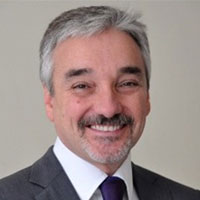PRESS AND NEWS CENTER
Luis Martinez-Amago Describes Impact of Cisco Integration on North American Market

 Luis Martinez-Amago, President of Technicolor USA and also President of the Connected Home North America division of Technicolor
Luis Martinez-Amago, President of Technicolor USA and also President of the Connected Home North America division of TechnicolorAs the first anniversary of the acquisition approaches Luis Martinez-Amago, President of Technicolor USA and also President of the Connected Home North America division of Technicolor, reviews progress and sets out his vision for the future of the combined businesses in North America.
- Technicolor acquired Cisco’s Connected Devices division on November 21st, 2015, and has now integrated that business with the Technicolor Connected Home business.
- In North America, the merger has elevated Technicolor from being a significant player to a major player in the connected home market. In combination with Arris’ acquisition of Pace, has reshaped the market, reducing choice for major customers and leaving them more exposed to any shortcomings of these suppliers.
- To capitalize on the acquisition and to address the changed market conditions, Luis Martinez-Amago, the head of Technicolor’s enlarged Connected Home business in North America, has embarked on an ambitious program to make the business more customer centric, and internally much more collaborative.
Luis, we are approaching the one year anniversary since Cisco’s Connected Devices division joined forces with Technicolor. What were your expectations as you came into this region, and what impact did this integration have on our position in the North American market?
Martinez-Amago: We have achieved a number of the big objectives we set at the beginning of the integration process. What we sell to customers is performance. They are expecting performance across every aspect of their engagement with us: engineering, a very high performing supply chain and flawless execution across the lifetime of a project. This is what we sell.
Our objective this year was to realign the action plan across the two organizations CDBU and Technicolor so that we could integrate the two companies into one single organization; from the way we run engineering projects to the way we supply customers.
More importantly, we needed to align the way we bring additional business through our sales and regional teams.
In my opinion we have achieved considerable success, increasing performance and bringing additional sales that will pave the way for a good business in the next two or three years.
With the integration of these two companies, we went from being a significant player to being a major player in the market, particularly here in North America. How has this changed the way we are seen by the customers you call on regularly?
Martinez-Amago: Customer perceptions have changed not only because of our new company, but because of our competitors. Arris and Pace have joined together, and the market has changed. For a number of years, the customer premises equipment space was a very fragmented market with customers buying from a number of vendors.
Now with the consolidation of Arris and Pace as well as Cisco Connected Devices and Technicolor, the relative importance of all the players from a customer perspective has changed. They have fewer choices, which means they are more exposed to the quality and the performance of those players.
This is why, in my opinion, the key to success is execution. Being bigger enables us to perform better because we can leverage economies of scale on a number of fronts. That will be key. In the coming years, we must be able to show customers that they can trust us, that they can give us any category, any product and any service they need.
Following the merger what new operational realities are you dealing with? Has the organization changed to the point that we now approach customers differently?
Martinez-Amago: We have a new focus on customer centricity because we are in a service business, at least with the very big operators in North America. They buy engineering services and supply chain services from us. To that end, we have launched a “Proximity Project” to position key people close to our customers geographically, and also functionally.
We are making what we might have considered in the past to be back office activities and positioning them as front office activities. We are doing this to assure customers that we have transparency, that they can inspect our performance and see that we measure the way we perform for them.
We are adopting quite a drastic approach to customer centricity and this is paying off. The feedback from customers is that they tend to trust us more if they know when we are having issues and they have the transparency into how we are fixing those issues. Because we are more open and transparent, they are more confident that when we commit to do something, we will do it.
Have your customers remarked on this change? Are we a different company from a cultural standpoint?
Martinez-Amago: The answer to that is yes, based on feedback from our key customers in North America: Comcast, Charter, AT&T and others. They have expressed to me that they are happy with our new way of operating. We are getting this feedback from all levels -- not only top management and sales -- but also at the engineering and supply chain level.
They are pretty happy with what they have seen over the past 12 months, but they are expecting much more because, as I have said, they are much more exposed to us than they were in the past. So, if we fail, the impact on them will be bigger.
Their expectations are high, but the feedback we are getting is extremely positive and encouraging for the future.
As you came into your position here at Technicolor, what were the key investments you wanted to make in the new Connected Home North America organization?
Martinez-Amago: One was the Proximity Project. We have opened an office in Philadelphia and we have assigned a number of key leaders in this office to be close to Comcast.
We are doing the same in Denver. We already had an office in El Segundo. We are moving people into Canada because we need to have people close to our customers there. This is one of our big investments, and it is paying off.
A second big investment is into new processes for our sales approach, into the way sales people engage with the rest of the company, into how we track new opportunities, and how product management and engineering follow the key opportunities we want to win.
We have implemented a very easy-to-use information sharing system. This is having an impact, because now everybody knows what is happening every day, regardless of the account we are dealing with. It also increases the effectiveness of the sales process.
We will not stop there.
We will keep evolving everything we do around customers in order to make sure we keep ahead of our traditional competitors.
Whenever you make an investment you look to get a return on that investment. What are the key metrics you are monitoring to ensure we are doing what is right for our customers and that we meet the key objectives you have set for your team in this region?
Martinez-Amago: The main KPIs we follow are, first of all, how many of the opportunities in the market we are winning, the amount of dollars at play in the market where we compete, and how many dollars we have been winning. The achievement of those KPIs means we are executing well.
There is a second set of KPIs relating to the way we execute. These are around what we call the Spider Chart. We measure not only the sales performance but also engineering and supply chain performance. We share these KPIs with our customers in order to make the conversation objective and unemotional: we are able to discuss the areas where we are good or bad, the issues we face, and the areas where our customer is expecting us to improve.
What about some of the new technology developments making the headlines?
Martinez-Amago: There are several new technologies emerging that we need to address and achieve leadership in. One is DOCSIS 3.1 for cable. Our key customers are launching that already. It will be a key technology over the next couple of years that everybody will embrace.
Also, there are over the top set-top boxes (OTT STBs) in which we already enjoy significant leadership. This is a new technology because a number of operators are trying to launch diversified offers. Through our investment in Skipper (our Android-based set-top box) and our understanding of and early engagement with Google to introduce Android into our hardware, we are really showing the market that we have a significant lead.
The OTT initiative is of particular interest. Was there anything about the integration of the Cisco Connected Devices division with Technicolor that advanced that particular technology?
Martinez-Amago: Yes, because we are now perceived as a leader in video. Both companies had a presence in the video market, but served different customers. The integration was very complementary in terms of the customer footprint.
However, OTT is a new technology that neither company was selling at the time of our acquisition of Cisco Connected Devices and since then, we have won a number of new contracts. We will start shipping products for these new contracts at the end of this year, some of them taking advantage of the Black Friday commercial boom. I expect this business to keep increasing as more of our customers launch this type of initiative.
It is interesting that we have achieved a leadership position in the OTT space as a joint company, which I guess speaks to the quality of the teamwork between the employees of the two companies. Was there a significant amount of collaboration between the two companies to develop these OTT solutions?
Martinez-Amago: Having bigger teams with a wider portfolio and wider customer base generated the capacity and capability to address more topics, more initiatives and to have a much greater customer impact.
These things would have been more difficult to achieve by either company on its own, because they had much more limited focus. This is one of the benefits of scale.
Looking ahead, what are your objectives going forward for the next year?
Martinez-Amago: To gain market share from our competitors.
There are two main competing forces. One is Arris. We need to really take share from them in all accounts. The other is the group of small but specialized suppliers. Our key objective is to gain share from these two blocks of competitors, and with the right level of profitability.
Another key objective is cultural change. I see a significant evolution to a much more winning mentality where everything is possible. We need to fight for the difficult and even the impossible things the market offers us.
I also want to emphasize the collaboration aspects of our culture: sharing and meeting. We are not limiting trips when people need to go and meet customers, or to have team meetings.
We will also be moving to a more open office environment in which people can feel the pulse of the business, not only from formal reports and emails, but an environment in which they will live the business, where they will see when there is a celebration, a crisis.
This is the modern way of working and should be part of our culture. We need to develop a fighting spirit, a winning mentality, and a sharing environment.